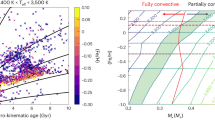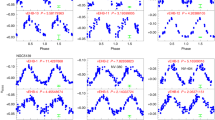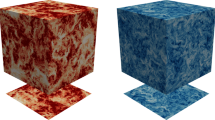Abstract
One interpretation of the activity and magnetism of late-type stars is that these both intensify with decreasing Rossby number up to a saturation level1,2,3, suggesting that stellar dynamos depend on both rotation and convective turbulence4. Some studies have claimed, however, that rotation alone suffices to parametrize this scaling adequately5,6. Here, we tackle the question of the relevance of turbulence to stellar dynamos by including evolved, post-main-sequence stars in the analysis of the rotation–activity relation. These stars rotate very slowly compared with main-sequence stars, but exhibit similar activity levels7. We show that the two evolutionary stages fall together in the rotation–activity diagram and form a single sequence in the unsaturated regime in relation only to Rossby numbers derived from stellar models, confirming earlier preliminary results that relied on a more simplistic parametrization of the convective turn-over time8,9. This mirrors recent results of fully convective M dwarfs, which likewise fall on the same rotation–activity sequence as partially convective solar-type stars10,11. Our results demonstrate that turbulence plays a crucial role in driving stellar dynamos and suggest that there is a common turbulence-related dynamo mechanism explaining the magnetic activity of all late-type stars.
This is a preview of subscription content, access via your institution
Access options
Access Nature and 54 other Nature Portfolio journals
Get Nature+, our best-value online-access subscription
$29.99 / 30 days
cancel any time
Subscribe to this journal
Receive 12 digital issues and online access to articles
$119.00 per year
only $9.92 per issue
Buy this article
- Purchase on Springer Link
- Instant access to full article PDF
Prices may be subject to local taxes which are calculated during checkout



Similar content being viewed by others
Data availability
The MWO HK Project data are available online at ftp://solis.nso.edu/MountWilson_HK/, and Gaia Data Release 2 from the Gaia Archive at http://gea.esac.esa.int/archive/. The YaPSI stellar models are available at http://www.astro.yale.edu/yapsi/. The adopted and derived astrophysical parameters for the stellar sample used in this study are available in online tables at the Strasbourg Astronomical Data Center via anonymous ftp to cdsarc.u-strasbg.fr (130.79.128.5) or via http://cdsarc.u-strasbg.fr/viz-bin/qcat?J/other/NatAs.
References
Mamajek, E. E. & Hillenbrand, L. A. Improved age estimation for solar-type dwarfs using activity–rotation diagnostics. Astrophys. J. 687, 1264–1293 (2008).
Wright, N. J., Drake, J. J., Mamajek, E. E. & Henry, G. W. The stellar-activity–rotation relationship and the evolution of stellar dynamos. Astrophys. J. 743, 48 (2011).
Reiners, A., Basri, G. & Browning, M. Evidence for magnetic flux saturation in rapidly rotating M stars. Astrophys. J. 692, 538–545 (2009).
Charbonneau, P. Dynamo models of the solar cycle. Living Rev. Sol. Phys. 7, 3 (2010).
Pizzolato, N., Maggio, A., Micela, G., Sciortino, S. & Ventura, P. The stellar activity–rotation relationship revisited: dependence of saturated and non-saturated X-ray emission regimes on stellar mass for late-type dwarfs. Astron. Astrophys. 397, 147–157 (2003).
Reiners, A., Schüssler, M. & Passegger, V. M. Generalized investigation of the rotation–activity relation: favoring rotation period instead of Rossby number. Astrophys. J. 794, 144 (2014).
Strassmeier, K. G., Fekel, F. C., Bopp, B. W., Dempsey, R. C. & Henry, G. W. Chromospheric Ca ii H and K and H-alpha emission in single and binary stars of spectral types F6–M2. Astrophys. J. Suppl. Ser. 72, 191–230 (1990).
Basri, G. Stellar activity in synchronized binaries. II. A correlation analysis with single stars. Astrophys. J. 316, 377–388 (1987).
Young, A., Ajir, F. & Thurman, G. Chromospheric activity in evolved stars: the rotation–activity connection and the binary-single dichotomy. Publ. Astron. Soc. Pac. 101, 1017–1031 (1989).
Wright, N. J. & Drake, J. J. Solar-type dynamo behaviour in fully convective stars without a tachocline. Nature 535, 526–528 (2016).
Newton, E. R. et al. The Hα emission of nearby M dwarfs and its relation to stellar rotation. Astrophys. J. 834, 85 (2017).
Noyes, R. W., Hartmann, L. W., Baliunas, S. L., Duncan, D. K. & Vaughan, A. H. Rotation, convection, and magnetic activity in lower main-sequence stars. Astrophys. J. 279, 763–777 (1984).
Gunn, A. G., Mitrou, C. K. & Doyle, J. G. On the rotation–activity correlation for active binary stars. Mon. Not. R. Astron. Soc. 296, 150–164 (1998).
Vidotto, A. A. et al. Stellar magnetism: empirical trends with age and rotation. Mon. Not. R. Astron. Soc. 441, 2361–2374 (2014).
Aurière, M. et al. The magnetic fields at the surface of active single G-K giants. Astron. Astrophys. 574, A90 (2015).
Gilliland, R. L. The relation of chromospheric activity to convection, rotation, and evolution off the main sequence. Astrophys. J. 299, 286–294 (1985).
Babcock, H. W. The topology of the Sun’s magnetic field and the 22-year cycle. Astrophys. J. 133, 572–587 (1961).
Leighton, R. B. A magneto-kinematic model of the solar cycle. Astrophys. J. 156, 1–26 (1969).
Parker, E. N. The formation of sunspots from the solar toroidal field. Astrophys. J. 121, 491–507 (1955).
Weber, M. A., Fan, Y. & Miesch, M. S. The rise of active region flux tubes in the turbulent solar convective envelope. Astrophys. J. 741, 11 (2011).
Käpylä, P. J., Mantere, M. J. & Brandenburg, A. Cyclic magnetic activity due to turbulent convection in spherical wedge geometry. Astrophys. J. Lett. 755, L22 (2012).
Augustson, K., Brun, A. S., Miesch, M. & Toomre, J. Grand minima and equatorward propagation in a cycling stellar convective dynamo. Astrophys. J. 809, 149 (2015).
Nelson, N. J., Brown, B. P., Brun, A. S., Miesch, M. S. & Toomre, J. Buoyant magnetic loops generated by global convective dynamo action. Solar Phys. 289, 441–458 (2014).
Skumanich, A. Time scales for Ca ii emission decay, rotational braking, and lithium depletion. Astrophys. J. 171, 565–567 (1972).
Spada, F., Gellert, M., Arlt, R. & Deheuvels, S. Angular momentum transport efficiency in post-main sequence low-mass stars. Astron. Astrophys. 589, A23 (2016).
Ceillier, T. et al. Surface rotation of Kepler red giant stars. Astron. Astrophys. 605, A111 (2017).
Wilson, O. C. Chromospheric variations in main-sequence stars. Astrophys. J. 226, 379–396 (1978).
Spada, F., Demarque, P., Kim, Y.-C., Boyajian, T. S. & Brewer, J. M. The Yale–Potsdam Stellar Isochrones. Astrophys. J. 838, 161 (2017).
Wright, N. J., Newton, E. R., Williams, P. K. G., Drake, J. J. & Yadav, R. K. The stellar rotation–activity relationship in fully convective M dwarfs. Mon. Not. R. Astron. Soc. 479, 2351–2360 (2018).
Mittag, M., Schmitt, J. H. M. M. & Schröder, K. P. Revisiting the connection between magnetic activity, rotation period, and convective turnover time for main-sequence stars. Astron. Astrophys. 618, A48 (2018).
Lehtinen, J., Jetsu, L., Hackman, T., Kajatkari, P. & Henry, G. W. Activity trends in young solar-type stars. Astron. Astrophys. 588, A38 (2016).
Egeland, R. et al. The Mount Wilson Observatory S-index of the Sun. Astrophys. J. 835, 25 (2017).
Olspert, N., Lehtinen, J. J., Käpylä, M. J., Pelt, J. & Grigorievskiy, A. Estimating activity cycles with probabilistic methods. II. The Mount Wilson Ca H&K data. Astron. Astrophys. 619, A6 (2018).
Rutten, R. G. M. Magnetic structure in cool stars. VII. Absolute surface flux in Ca ii H and K line cores. Astron. Astrophys. 130, 353–360 (1984).
Cox, A. N. (ed.) Allen’s Astrophysical Quantities 4th edn (Springer, 2000).
Battrick, B. (ed.) The Hipparcos and Tycho Catalogues: Astrometric and Photometric Star Catalogues Derived from the ESA Hipparcos Space Astrometry Mission Special Publication No. SP-1200 (ESA, 1997).
Gaia Collaboration et al. The Gaia mission. Astron. Astrophys. 595, A1 (2016).
Gaia Collaboration et al. Gaia Data Release 2: summary of the contents and survey properties. Astron. Astrophys. 616, A1 (2018).
Luri, X. et al. Gaia Data Release 2: using Gaia parallaxes. Astron. Astrophys. 616, A9 (2018).
van Leeuwen, F. Validation of the new Hipparcos reduction. Astron. Astrophys. 474, 653–664 (2007).
Vergely, J. L., Egret, D., Freire Ferrero, R., Valette, B. & Koeppen, J. The Extinction in the Solar Neighbourhood from the HIPPARCOS Data in Hipparcos: Venice ’97 Special Publication No. SP-402 (eds Perryman, M. A. C. et al.) 603–606 (ESA, 1997).
Andrae, R. et al. Gaia Data Release 2: first stellar parameters from Apsis. Astron. Astrophys. 616, A8 (2018).
Gáspár, A., Rieke, G. H. & Ballering, N. The correlation between metallicity and debris disk mass. Astrophys. J. 826, 171 (2016).
Flower, P. J. Transformations from theoretical Hertzsprung–Russell diagrams to color–magnitude diagrams: effective temperatures, B − V colors, and bolometric corrections. Astrophys. J. 469, 355–365 (1996).
Gray, D. F. The Observation and Analysis of Stellar Photospheres (Cambridge Univ. Press, 2005).
Soubiran, C., LeCampion, J.-F., Brouillet, N. & Chemin, L. The PASTEL catalogue: 2016 version. Astron. Astrophys. 591, A118 (2016).
Bastien, F. A., Stassun, K. G., Basri, G. & Pepper, J. An observational correlation between stellar brightness variations and surface gravity. Nature 500, 427–430 (2013).
Kim, Y.-C. & Demarque, P. The theoretical calculation of the Rossby number and the ‘nonlocal’ convective overturn time for pre-main-sequence and early post-main-sequence stars. Astrophys. J. 457, 340–347 (1996).
Serenelli, A. M., Bergemann, M., Ruchti, G. & Casagrande, L. Bayesian analysis of ages, masses and distances to cool stars with non-LTE spectroscopic parameters. Mon. Not. R. Astron. Soc. 429, 3645–3657 (2013).
Silva Aguirre, V. & Serenelli, A. M. Asteroseismic age determination for dwarfs and giants. Astron. Nachr. 337, 823–826 (2016).
Wang, Y., Khardon, R. & Protopapas, P. Nonparametric Bayesian estimation of periodic light curves. Astrophys. J. 756, 67 (2012).
Lehtinen, J., Jetsu, L., Hackman, T., Kajatkari, P. & Henry, G. W. The continuous period search method and its application to the young solar analogue HD 116956. Astron. Astrophys. 527, A136 (2011).
Barber, D. Bayesian Reasoning and Machine Learning (Cambridge Univ. Press, 2012).
Stoica, P. & Selen, Y. Model-order selection: a review of information criterion rules. IEEE Signal Process. Mag. 21, 36–47 (2004).
Mahalanobis, P. C. On the generalized distance in statistics. Proc. Natl Inst. Sci. India 2, 49–55 (1936).
Acknowledgements
This work has made use of data from the European Space Agency (ESA) mission Gaia (https://www.cosmos.esa.int/gaia), processed by the Gaia Data Processing and Analysis Consortium (DPAC, https://www.cosmos.esa.int/web/gaia/dpac/consortium). Funding for DPAC has been provided by national institutions, in particular the institutions participating in the Gaia Multilateral Agreement. The chromospheric activity data derive from the Mount Wilson Observatory HK Project, which was supported by both public and private funds through the Carnegie Observatories, the Mount Wilson Institute and the Harvard-Smithsonian Center for Astrophysics, starting in 1966 and continuing for over 36 years. These data are the result of work by O. Wilson, A. Vaughan, G. Preston, D. Duncan, S. Baliunas and others. The work has made use of the SIMBAD database at CDS, Strasbourg, France, and NASA’s Astrophysics Data System (ADS) services. J.J.L. acknowledges financial support from the Independent Max Planck Research Group ‘SOLSTAR’. F.S. acknowledges the support of the German space agency (Deutsches Zentrum für Luft- und Raumfahrt) under PLATO Data Center grant 50OO1501. M.J.K., N.O. and P.J.K. acknowledge the support of the Academy of Finland ReSoLVE Centre of Excellence (grant no. 307411). P.J.K. acknowledges support from DFG Heisenberg (grant no. KA 4825/2-1). This project has received funding from the European Research Council (ERC) under the European Union’s Horizon 2020 research and innovation programme (Project UniSDyn, grant agreement no. 818665).
Author information
Authors and Affiliations
Contributions
All authors contributed to the research and its design. J.J.L. and N.O. led the data analysis of the observations. F.S. led the stellar structure modelling. M.J.K. and P.J.K. led the theoretical interpretation of the obtained results. All authors contributed to the discussion of the results and to the manuscript.
Corresponding author
Ethics declarations
Competing interests
The authors declare no competing interests.
Additional information
Peer review information Nature Astronomy thanks Gopal Hazra and the other, anonymous, reviewer(s) for their contribution to the peer review of this work.
Publisher’s note Springer Nature remains neutral with regard to jurisdictional claims in published maps and institutional affiliations.
Extended data
Extended Data Fig. 1 Chromospheric Ca II H&K emission ratio, \({R}_{{\rm{HK}}}^{\prime}\) against the stellar rotation period Prot.
The diagram shows giant stars as a distinct population with comparable activity levels but notably longer rotation periods than main sequence stars, in contrast to the common rotation-activity sequence seen using the Rossby number. The colour scale indicates surface gravity, log g, as in Fig. 2a and the position of the Sun is indicated by the circled dot symbol.
Extended Data Fig. 2 Gaussian clustering for the rotation-activity relation.
a, Chromospheric Ca II H&K emission ratio, \({R}_{{\rm{HK}}}^{\prime}\), vs. Rossby number, Ro. b, Chromospheric Ca II H&K emission ratio, \({R}_{{\rm{HK}}}^{\prime}\), vs. combined rotation period and stellar radius, \({P}_{{\rm{rot}}}^{-2}{R}^{-4}\). c, Chromospheric Ca II H&K luminosity LHK vs. rotation period, Prot. Optimal clustering of the data is indicated by the blue and red ellipses, reflecting the corresponding 95% confidence regions, and individual stars are coloured according to their inferred cluster membership.
Extended Data Fig. 3 Rotation-activity relations using the chromospheric Ca II H&K surface flux \({F}_{{\rm{HK}}}^{\prime}\).
a, Chromospheric surface emission flux, \({F}_{{\rm{HK}}}^{\prime}\), vs. stellar rotation period, Prot. b, Chromospheric surface emission flux, \({F}_{{\rm{HK}}}^{\prime}\), vs. Rossby number, Ro. The colour scale indicates surface gravity, log g, as in Fig. 2a and the position of the Sun is indicated by the circled dot symbol.
Extended Data Fig. 4 Metallicity distribution of the sample stars.
One low metallicity giant, HD 122563, with [Fe/H] = − 2.42 is left outside the shown metallicity range since it lacks both a determined Prot and τc value and so does not enter our analysis.
Extended Data Fig. 5 Selected stellar evolution tracks with the time evolution of convective turnover time, τc.
a, Evolution in the Hertzsprung-Russell (HR) diagram from the zero age main sequence (ZAMS) to the termination age main sequence (TAMS). b, Evolution in the HR diagram from TAMS to the red giant branch (RGB) tip. c, Evolution of τc from ZAMS to TAMS. d, Evolution of τc from TAMS to RGB tip. All ages are normalised to TAMS or RGB tip age.
Supplementary information
Rights and permissions
About this article
Cite this article
Lehtinen, J.J., Spada, F., Käpylä, M.J. et al. Common dynamo scaling in slowly rotating young and evolved stars. Nat Astron 4, 658–662 (2020). https://doi.org/10.1038/s41550-020-1039-x
Received:
Accepted:
Published:
Issue Date:
DOI: https://doi.org/10.1038/s41550-020-1039-x
This article is cited by
-
An abrupt change in the stellar spin-down law at the fully convective boundary
Nature Astronomy (2023)
-
Turbulent Processes and Mean-Field Dynamo
Space Science Reviews (2023)
-
Evolution of Solar and Stellar Dynamo Theory
Space Science Reviews (2023)
-
Simulations of Solar and Stellar Dynamos and Their Theoretical Interpretation
Space Science Reviews (2023)



